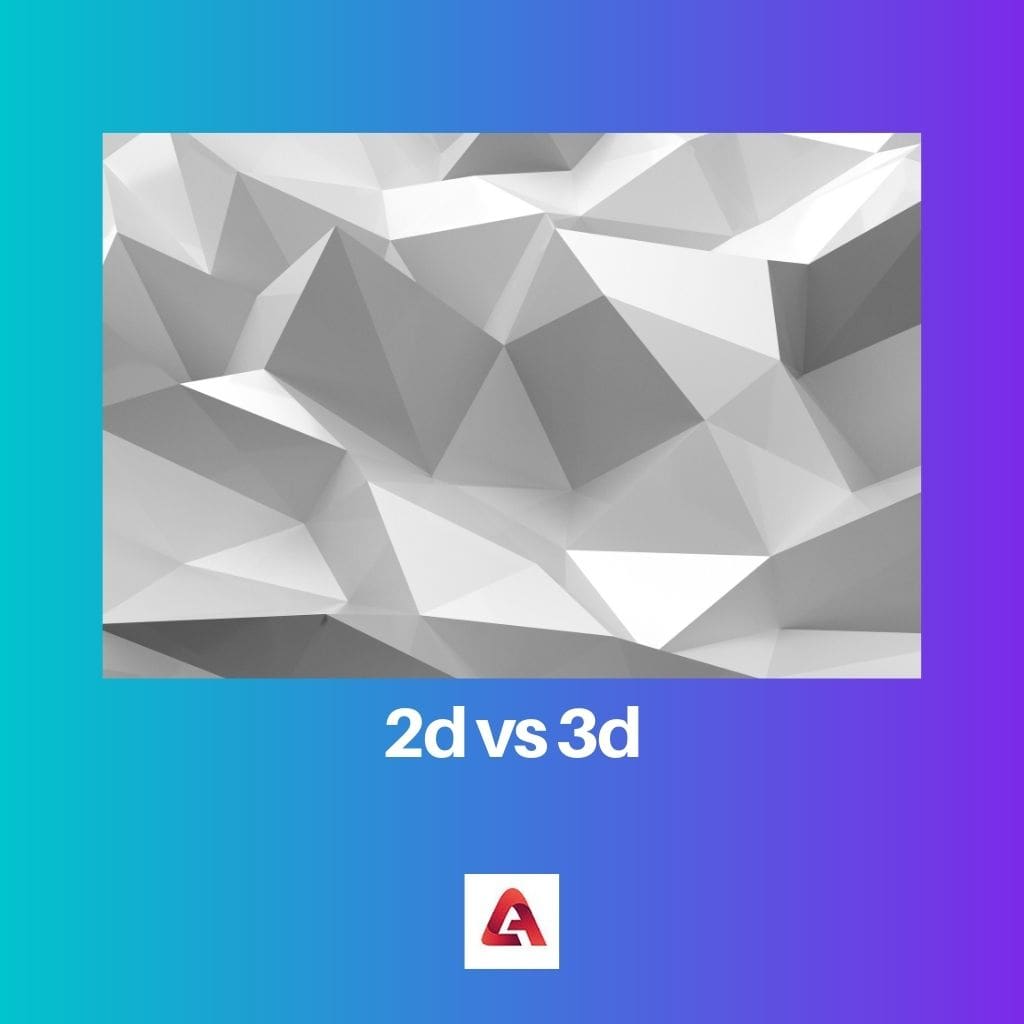The terms 2D and 3D stand for two-dimensional and three-dimensional, respectively. When defining the appearance or existence of a specific object in space, we use terms like two-dimensional or three-dimensional to describe its structure.
It means that the object either exists in two dimensions (length and breadth) or three dimensions (length, breadth and height). There also exists four-dimensional, five-dimensional, six, seven and so forth structures.
Key Takeaways
- 2D (two-dimensional) refers to objects or images with only two dimensions: length and width, which appear flat on a screen or surface.
- 3D (three-dimensional) refers to objects or images with three dimensions: length, width, and depth, giving the appearance of depth and volume.
- The choice between 2D and 3D depends on the desired visual effect, with 2D being simpler and more traditional and 3D offering a more immersive and realistic experience.
2D vs 3D
2D objects are flat and have two dimensions, used in graphic design, animation, and video games. 3D objects are created using computer graphics software and can be viewed from any angle or perspective, and are used in movies, video games, virtual reality, and architectural design.

A 2D-shaped object will comprise length and breadth, visible to our eyes. They are sometimes referred to as plane figures or flat shapes since their dimensions are limited to two-dimensional structures, not extending to height, appearing flat or plane to the eyes.
The most common examples of 2D structures can be a sheet of paper, circle, square, rectangle and pentagon.
A 3D-shaped object will comprise length, breadth and height, visible to our eyes. Unlike two-dimensional structures, they do not appear flat or plane. While 2D structure only uses two surfaces (X and Y axes) to deter its measurements, 3D uses other axes (Z) to give depth to its structure further.
Most common examples of 3D structures can be a cube, cuboid, prism, pyramid and cylinder.
Comparison Table
| Parameters of Comparison | 2D | 3D |
|---|---|---|
| Axes used | A two-dimensional structure uses only two axes, the x-axis and the y-axis. | A three-dimensional structure uses three axes, the x-axis, y-axis and z-axis, respectively. |
| Defining dimensions | Length and breadth | Length, breadth and height |
| Another name | They are also called “plane” or “flat” figures due to their appearance. | They are only referred to as 3D figures. |
| Examples | Circle, square, rectangle and pentagon. | Prism, cuboid, pyramid and cylinder. |
| Volume | Has no volume | Has volume |
What is 2D?
A 2D or a two-dimensional structure is an object existing in two dimensions to define its structure; that is, it exists in two planes or axes, the x-axis and y-axis, to determine its shape. A 2D figure has only length and width on the x-axis and y-axis, respectively.
Since two-dimensional figures can exist on a flat surface, they are also called plane figures or plane shapes. These figures do not have any volume, unlike 3D figures.
They exist on flat surfaces. They can see the area as much as possible, but they do not have any volume due to their restricting shape.
We have a variety of shapes and intangible structures encircling our daily lives. Out of these various shapes, 2D and 3D objects are the most common type of structure we come around.
Good examples of 2D structures can be sheets, circular objects, rectangular objects, square objects and pentagons.
These objects exist strictly within the periphery of the x-axis and y-axis. They cannot cross or overtop these two margins, which is unusual for 3D structures.
Geometrically speaking, two-dimensional objects can be seen as existing in between two imaginary dimensions/planes, labelled as the x-axis and y-axis, respectively.

What is 3D?
A 3D or a three-dimensional structure is an object existing in three dimensions to define its structure; that is, it exists in three planes or axes, the x-axis, y-axis and z-axis, to determine its shape. A 3D figure has length, width and height on the x-axis, y-axis and z-axis, respectively.
Unlike 2D figures, 3D figures exist beyond the margins of a flat or plane surface; they have a defining depth to their structure, extending to a new dimension called the z-axis. This added axis is to determine the height of the figure.
Since they do not exist within the parameters of two dimensions, they are not plane or flat figures. Instead, they have volume in them, which is a significant point of difference in 2D and 3D structures.
As mentioned earlier, we have a variety of shapes and intangible structures surrounding our daily lives. Of these various shapes, 2D and 3D objects are the most common structure we come across.
Good examples of 3D structures can be sheets, cuboid objects, pyramids, cylindrical objects and prisms.

Main Differences Between 2D and 3D
- A two-dimensional structure uses only two axes, the x-axis and the y-axis. At the same time, a three-dimensional structure uses three axes, the x-axis, y-axis and z-axis, respectively.
- A two-dimensional structure has only two surfaces; length and breadth. A three-dimensional structure has three surfaces; length, breadth and height.
- Two-dimensional figures are also called “plane” or “flat” due to their appearance. In contrast, three-dimensional figures are only referred to as 3D figures.
- Examples of two-dimensional structures are circles, squares, rectangles and pentagons. Examples of three-dimensional structures are Prism, cuboids, pyramids and cylinders.
- A two-dimensional structure has no volume. In comparison, a three-dimensional structure has volume.


Thank you for this enlightening article. It has broadened my knowledge of 2D and 3D figures.
The comprehensive overview of 2D and 3D structures is commendable. The article succeeds in providing an in-depth understanding of these geometric concepts.
Absolutely, the article serves as an intellectual resource for understanding the dimensions of geometric figures.
The detailed comparison between 2D and 3D objects provides valuable insights. It is an intellectually stimulating read for those interested in geometry and spatial dimensions.
The engaging style of writing adds depth to the article, making it an enriching read for both students and enthusiasts of spatial geometry.
I couldn’t agree more. This article caters to a wide audience and effectively communicates complex concepts in a simplified manner.
I found this article to be very enlightening. The comparison between 2D and 3D is well articulated, making it easier to understand the differences.
I couldn’t agree more. The detailed explanation is beneficial for anyone looking to understand these concepts better.
Absolutely, the article breaks down the concepts in a comprehensive manner that is accessible to all readers.
This article provides a clear explanation of the difference between 2D and 3D objects, and their applications in various fields. It is highly informative and helpful.
I completely agree. It is essential information that is well-explained and easy to understand.
The article offers valuable insights into the world of 2D and 3D structures. It engages readers and encourages critical thinking about these concepts.
Indeed, the article serves as an excellent resource for understanding the fundamentals of 2D and 3D objects.
I found the comparison table particularly helpful in distinguishing the key characteristics of 2D and 3D shapes.
I appreciate the article’s thorough exploration of 2D and 3D structures. The real-world examples make the concepts relatable and understandable.
Absolutely, the inclusion of common examples enriches the content and facilitates a deeper grasp of the subject matter.
The article’s thoughtful analysis and illustrative examples make it an invaluable resource for anyone interested in the concepts of 2D and 3D objects.
Certainty, the content is remarkably insightful and presented in an engaging manner.
This article effectively communicates the characteristics of 2D and 3D shapes. The clear explanations contribute to a better understanding of these concepts.
Indeed, the author’s approach in presenting the material is both engaging and informative.
This write-up is insightful and educational. It dispels any confusion about 2D and 3D structures, providing a comprehensive examination of the topic.
I agree. The article effectively clarifies the attributes and applications of 2D and 3D shapes.